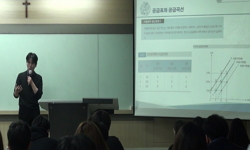With the rapid growth of computer vision applications, a large amount of video data in the Internet of Vehicles scenario are used for content analysis. Tasks based on video content understanding are usually accompanied by huge amount of calculation, w...
http://chineseinput.net/에서 pinyin(병음)방식으로 중국어를 변환할 수 있습니다.
변환된 중국어를 복사하여 사용하시면 됩니다.
- 中文 을 입력하시려면 zhongwen을 입력하시고 space를누르시면됩니다.
- 北京 을 입력하시려면 beijing을 입력하시고 space를 누르시면 됩니다.
Content-driven Joint Allocation of Communication and Computing Resources in Vehicular Networks
한글로보기https://www.riss.kr/link?id=A107388327
- 저자
- 발행기관
- 학술지명
- 권호사항
-
발행연도
2021
-
작성언어
English
- 주제어
-
자료형태
학술저널
- 발행기관 URL
-
수록면
265-268(4쪽)
- 제공처
-
0
상세조회 -
0
다운로드
부가정보
다국어 초록 (Multilingual Abstract)
With the rapid growth of computer vision applications, a large amount of video data in the Internet of Vehicles scenario are used for content analysis. Tasks based on video content understanding are usually accompanied by huge amount of calculation, which put great pressure on traditional wireless communication resource and Mobile Edge Computing (MEC) server computing resource. Furthermore, existing resource allocation schemes based on Quality of Service (QoS) or Quality of Experience (QoE) may not be the best choice for the purpose of video content understanding. In this paper, we propose a joint resource allocation scheme based on Quality of Content (QoC) to maximize the accuracy of video content understanding. Due to the real-time nature of resource allocation and the variability of the environment in autonomous driving scenarios, we design a Multi-agent Distributed Q-Learning algorithm to solve such multi-constrained nonlinear programming problems. Finally, the simulation results show that our proposed QoC-based joint resource allocation scheme has better video content understanding performance.
목차 (Table of Contents)
- Abstract
- I. INTRODUCTION
- II. SYSTEM MODEL AND PROBLEM FORMULATION
- III. PROBLEM SOLUTION
- IV. SIMULATION RESULTS
- Abstract
- I. INTRODUCTION
- II. SYSTEM MODEL AND PROBLEM FORMULATION
- III. PROBLEM SOLUTION
- IV. SIMULATION RESULTS
- V. CONCLUSION
- REFERENCES
동일학술지(권/호) 다른 논문
-
Cell-free UAV Communication in 6G Wireless Networks
- 한국통신학회
- Irfan Azam
- 2021
-
다양한 유형의 네트워크 침해 데이터의 연관성 분석 방안
- 한국통신학회
- 장영인(Jang Young-In)
- 2021
-
5G 어플리케이션을 위한 광대역 저잡음 증폭기에 관한 연구
- 한국통신학회
- 윤병철(Byeong-Cheol Yoon)
- 2021
-
W-band 0.1W 전력증폭기 MMIC 설계에 관한 연구
- 한국통신학회
- 이동민(Dong Min Lee)
- 2021




 DBpia
DBpia





